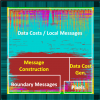Free Online Productivity Tools
i2Speak
i2Symbol
i2OCR
iTex2Img
iWeb2Print
iWeb2Shot
i2Type
iPdf2Split
iPdf2Merge
i2Bopomofo
i2Arabic
i2Style
i2Image
i2PDF
iLatex2Rtf
Sci2ools
178
Voted
CVPR
2009
IEEE
2009
IEEE
Hardware-Efficient Belief Propagation
Belief propagation (BP) is an effective algorithm for solving energy minimization problems in computer vision. However, it requires enormous memory, bandwidth, and computation because messages are iteratively passed between nodes in the Markov random field (MRF). In this paper, we propose two methods to address this problem.
The first method is a message passing scheme called tile-based belief propagation. The key idea of this method is that a message can be well approximated from other faraway ones. We split the MRF into many tiles and perform BP within each one. To preserve the global optimality, we store the outgoing boundary messages of a tile and use them when performing BP in the neighboring tiles. The tile-based BP only requires 1-5% memory and 0.2-1% bandwidth of the ordinary BP.
The second method is an O(L) message construction algorithm for the robust functions commonly used for describing the smoothness terms in the energy function. We find that many variables in construct...
Belief Propagation | Computer Vision | CVPR 2009 | Embedded Systems | Markov Random Field | Parallel Processing | VLSI |
Related Content
| Added | 29 Apr 2009 |
| Updated | 10 Dec 2009 |
| Type | Conference |
| Year | 2009 |
| Where | CVPR |
| Authors | Chao-Chung Cheng, Chia-Kai Liang, Homer H. Chen, Liang-Gee Chen, Yen-Chieh Lai |
Comments (0)


